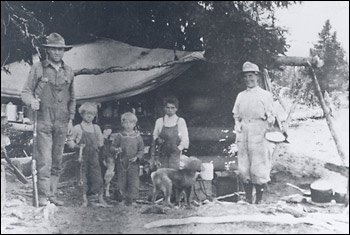home | internet service | web design | business directory | bulletin board | advertise | events calendar | contact | weather | cams

|
Coming Off the Range About 2,800 cattle annually graze the lower roaded elevations surrounding the Methow Valley, according to Forest Service range specialist Dean McFetridge. The cattle are starting to come off the range, ending a season that started June 1.
At one time, most of the cattle and sheep were herded to the Methow highlands all the way from the Columbia Basin. Stock driveways were the first routes into a lot of the backcountry here. Now much of the stock is from the Methow Valley, though some are trucked in and out.  In the summer of 1918, sheepherder Ross E. Smith, along In the summer of 1918, sheepherder Ross E. Smith, along with Victor, Omar, Emmet and Dell were camping in Horseshoe Basin about a quarter miles south of Kendall Camp. Photo from the Forest Service Collection, Courtesy of the Shafer Museum Grazing remained heavy through the 1930’s, but decreased through the 1940’s and 1950’s. “They grazed as long as they could,” said McFetridge, from snow melt to snowfall each year. And the high range was heavily used. McFetridge said there are some areas of the high country where historic sheep trailing still shows on the land. The last sheep grazing permit inside what is now wilderness was converted to a cattle permit in 1949, though some sheep grazed outside wilderness near Harts Pass and further east in Horseshoe Basin country into the 1990’s. Early range cattle were mostly Herefords which gradually gave way to cross-bred black Angus. But there is no livestock grazing in most of the high country now. “We are in the process of assessing whether any of the wilderness allotments are still suitable for grazing. We have closed one wilderness allotment,” said McFetridge. Logging roads built in the 1960s through the 1980s made big changes to grazing patterns: they opened up access to foraging areas for the cattle. The logging temporarily increased forage production. Ranchers and land managers had more convenient access to the range, which provided for better stock management. “Management standards got better,” said McFetridge. Managers started to “use the available range science in the 50’s and 60’s.” But that didn’t mean an end to long-standing controversies about how much--if any--grazing should be allowed on federal lands. The local ranger district is revising its grazing plans, and citizens are letting the managers know—both pro and con—what they think. Most opponents to re-issuing grazing permits say that grazing is just too destructive to the environment and the creatures that live there. Most recently, the Forest Service released a draft grazing allotment plan environmental analysis, which proposes to permit grazing in Libby, Little Bridge, Newby and Poorman Creek allotments for another ten years. The new plan would “reduce cattle impacts to riparian areas, threatened and endangered fish and wildlife and sensitive plants,” according to a Forest Service announcement. Managers would shift grazing patterns, improve some water developments and build a new one, plus build fencing to keep cattle out of sensitive areas in order to improve range conditions and reduce the impacts that cattle grazing has on wetlands, sensitive and rare plants, and fish. The comment period for the analysis ended September 17. The Ranger District received eight official comments. A couple more may still be in the mail—postmarked on September 17 or earlier. Ranger district staff will analyze and respond to the comments this week. They hope to have a decision notice about the grazing allotment plans signed by the Okanogan-Wenatchee Forest Supervisor by the end of September. 09/26/2011 |
